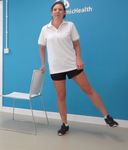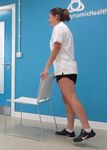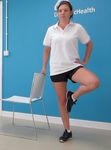Advice and exercises for managing knee and hip osteoarthritis
←
→
Page content transcription
If your browser does not render page correctly, please read the page content below
Advice and exercises for managing
knee and hip osteoarthritis
0496 October 2018 V1.2
April 2018
April 2021This advice and exercise booklet has been produced by senior physiotherapists What other help is available?
working for DynamicHealth. It offers simple advice and exercises to help you
safely manage your symptoms, often the right advice and exercises are all that is Steroid injections
needed. This leaflet has been made available to your GP, who may ask you to try Steroid injections are mainly used for very painful Osteoarthritis.
the advice and exercises prior to physiotherapy input. They are not clinically suitable for everyone but can help some patients
significantly. The injection is given directly into your joint.
What is osteoarthritis? It can start to work within a day or so and may improve pain for several weeks
or even months.
Osteoarthritis is a condition that affects the joints, and can cause pain and
If successful the injection will provide short term relief but is not a fix.
stiffness. This condition is also known as age related changes or wear and tear. It
is the most common form of joint condition, with the knee most commonly affected. Reducing pain through exercises that stretch and strengthen joints, muscles,
and other soft tissues will provide longer term relief.
What are the symptoms of Osteoarthritis?
Joint replacement surgery
Typical physical signs are:
This may be considered as a suitable treatment option if you have or develop
Tenderness over the joint
uncontrolled, intense, persistent pain resulting in substantial impact on your life.
Creaking of the joint This means pain of almost continuous nature (e.g. pain when standing or
Joint swelling walking on level surfaces for less than half an hour and requiring the use of
Restricted movement walking aids).
Decreased joint stability You may find you are having to continuously use anti-inflammatory pain-relief
Weakness of your thigh muscles. medication to control symptoms.
There would be significant limitation of daily activities (e.g. you may be only
How is Osteoarthritis diagnosed? being able to complete a few or none of your normal activities and
self-care). However, it is important that you have had symptoms for at least 6
Clinical diagnosis is made based on signs and symptoms. months and trialled conservative management (e.g. exercises, pain relief) for at
An x-ray may show the degree of Osteoarthritis. least 3 months, as flare-ups of pain in osteoarthritic joints can settle within this
Blood tests may rule out other forms of Arthritis. timeframe.
How can I improve my general aerobic fitness?
Top 5 tips for managing knee or hip osteoarthritis
In short anything that raises your heart rate.
1. Try to keep to a healthy weight, it will help to reduce pain and strain on your
joints. Two main ways are:
2. Wear sensible, well-fitting shoes (e.g. trainers) to cushion the impact of
1. Through activity - swimming, walking, cycling, fitness classes etc.
walking.
2. By adding a warm up to your strengthening exercises - marching on the
3. Keep active but pace yourself – don’t overdo it on ‘good’ days and keep spot, and seated marching on the spot.
moving on ‘bad’ days by altering your activities.
4. Apply a heat or ice pack to ease pain and stiffness. Ensure you protect your You can find the latest information on local fitness schemes on our website -
skin to avoid burns or irritation. Do not use ice if you have poor sensation over http://www.eoemskservice.nhs.uk/community or by scanning the
the area, an infected wound, Raynauds Syndrome, or Cryoglobulinaemia. QR code.
5. Don’t stay in the same position for long periods of time (e.g. sitting,
lying). If you are struggling to walk and need assistance, walking aids can be
provided by the NHS. If you wish to purchase your own, please seek
assistance in measuring to ensure the right fit.Section G - Joint movement and stretching How much exercise to do?
Pick one exercise from this section Please complete exercises once or twice a day, following the advice below.
A) Knee flexion/extension Aim to achieve within the middle range (5-7 out of 10).
1. Lie on your back. The exercises are generally in order of difficulty.
Repeat the exercise until you feel you have achieved this level of intensity.
2. Bend your knee as far as is comfortable. If you feel you are working beyond this, it may be that the exercise is too
Hold for several seconds before returning to difficult so you should return to the previous exercise.
the starting position.
If you do not reach this, it may be that the exercise is too easy, so you may
3. You may wish to assist further using your wish to progress onto the next exercise.
hands or with a towel around your shin. The lying exercises can be done on the floor or on a bed - you can use a
pillow.
B) Knee hugs The standing exercises should be done with support available, should you
1. Lie on your back with your knees bent. need it.
This is a guide to measure how hard you feel your body is working during physical
2. Lift one knee up towards your chest. Hold for activity. You do not need to do a certain number of exercises but rather stop when
several seconds before returning to the you get above level 7 or cannot do anymore.
sitting position.
3.
You may wish to assist further using your Rating of Perceived Exertion
hands.
C) Quadriceps stretch Level of
Description
Exertion
1. Stand with something to lean against.
1 Inactive/very Little or no effort at all.
2. Bend your knee as far as is comfortable. Take hold of light Anything other than sleeping or complete rest.
your ankle with your hand and gently pull your foot
closer to your buttock. Feel the stretch along the front 2-3 Light Slow walking or jogging at your own very comfortable pace.
of the thigh. Could maintain/keep going for hours, breathing easily and can
carry a conversation.
3. Hold for 20-30 seconds before slowly returning to the
starting position. 4 Slightly Breathing heavier and heart rate a little faster, feeling
more effort warmer. Can hold short conversation.
D) Hamstring stretch
5 Medium/ Still reasonably comfortable.
1. Stand with one leg out in front and the other knee
somewhat You don’t want to stop yet, but if you went much harder you’d
slightly bent. hard be uncomfortable.
2. Keeping your back straight, bend forwards from the
hips. Feel the stretch along the back of the straight 6 Moderate/ Breathing hard, sweating, hard to talk.
leg. Hold for 20-30 seconds before slowly returning to hard
the starting position. 7 Hard/ On the verge of becoming uncomfortable.
Vigorous Short of breath, but can speak a sentence.
E) Calf stretch
8 Very hard You can still go on, but you really have to push yourself.
1. Stand with something to lean against. Breathing very hard, can only say a few words.
2. Take one foot forwards and the other backwards. 9 Extremely Cannot sustain the effort for very long.
Keeping the toes pointing forwards and the heel of the hard Can barely breathe and speak a single word.
back foot on the floor, bend the front knee. Feel the
stretch along the back of the back leg. Hold for 20-30 10 Hardest/ Feeling almost impossible to keep going. Completely out of
seconds before slowly returning to the starting Maximum breath, unable to talk. Your limit.
position. effort/flat outSimple exercises for knee and hip osteoarthritis Section F - Balance
See sections A-E for exercises to strengthen muscles around the hip and knee
See section F for exercises to improve balance and mobility Pick at least one exercise from this section.
See section G for exercises to improve joint range of movement and stretches
A) Single-leg stand
It is advised that you pick one exercise from each section, unless stated otherwise
by your physiotherapist. 1. Stand with something to lean against.
Section A - Hip Extension 2. Lift one foot off the floor and balance for as long as
possible.
A) Bridge
1. Lie on your back with your knees bent as
far as comfortable.
2. Tense your tummy muscles, clench your
buttock muscles and lift your bottom off
the floor or bed. Hold for several
seconds before slowly returning to the
starting position. B) Heel-toe walking
3. You can progress by transferring your weight onto one 1. Stand and place one foot in front of the other.
leg, to straighten the other, but make sure that your 2. Practice walking heel-to-toe, as if you are on a
hips remain level (single-leg bridge). balance beam or tightrope.
3. Try to look straight ahead.
B) Hip extension in standing
4. Alternatively, you can practice walking on your heels
1. Stand with something to lean against. or on your toes.
2. Tense your tummy muscles and clench your buttock
muscles to bring your leg backwards, keeping your
knee straight. Try to keep your body upright. Hold for
several seconds before slowly returning to the
starting position.
3. If this is difficult, you can try doing it leaning forwards C) Heel raises
onto a firm surface, such as a table.
1. Stand with something to lean against.
4. You can progress by adding resistance with an
exercise band, which is tied around your ankle and 2. Push up on your toes. Hold for several seconds
anchored to a stable structure in front of you. before slowly returning to the starting position.
3. You can progress by doing this on one leg.
C) Backwards walking
1. Ensure that you do this in a safe environment, so that
you have something to hold onto, should you lose your
balance.
2. Slowly, repeatedly, place one foot behind the other to
walk backwards. You can progress by wearing ankle
weights.Section E - Knee Extension (weight bearing) Section B - Hip Abduction
Pick at least one exercise from this section. A) Hip abduction in side lying
A) Sit-to-stand 1. Lie on your side with the underneath leg
bent and the upper leg straight.
1. Sit on the edge of a chair. Place your feet hip-width
apart with toes pointing forwards. 2. Lift the upper leg straight up with the toes
pointing forwards and the ankle leading
2. Lean forwards and stand up from the chair, keeping the movement. Try to keep the leg in line
your knees hip-width apart and keeping your arms with your body. Hold for several seconds
folded, if possible. Slowly return to sitting again. before slowly returning to the starting
position.
3. Alternatively, you can stand behind the chair and use
this to hold as you do a mini-squat. You can progress
by stepping away from the chair and doing a full B) Hip abduction in standing
squat. 1. Stand up straight with something to lean against.
2. Lift your leg sideways with the toes pointing forwards
B) Single-leg knee dips and the ankle leading the movement. Try to keep your
1. Stand with something to lean against. body upright. Hold for several seconds before slowly
returning to the starting position.
2. Lift one foot off the ground and perform a small knee
bend on your standing leg. Try to keep your weight 3. You can progress by adding resistance with an
backwards and your knee in line with your toes. exercise band, which is tied around your ankle and
Slowly return to the starting position. anchored to a stable structure out to one side, so that
the band crosses in front of the opposite leg.
C) Side stepping
C) Step ups and step downs 1. Ensure that you do this in a safe environment, so that
you have something to hold onto, should you lose your
1. Stand facing a step. Step up balance.
several times with one leg
leading and then the other. 2. Take one foot out to the side, leading with the ankle.
Transfer your weight onto this leg and allow the other
2. Now try step downs - stand leg to come towards it. Continue to side-step in one
completely on a step, facing direction, before repeating in the opposite direction.
downwards. Step down with
one leg leading and then the 3. You can progress by wearing ankle weights.
other.Section C - Hip External Rotation Section D - Knee Extension (non-weight-bearing)
Pick one exercise from this section. Pick one exercise from this section.
A) Clam A) Static quadriceps
1. Lie on your side with your knees bent 1. Lie on your back with one knee bent
and feet together. and the other leg straight.
2. Rotate from the hip to lift your top knee 2. Pull your toes up and tense your thigh
up as far as you can, without letting your muscles to push your knee down into
body follow the movement. the floor or bed. Hold for several
seconds before slowly relaxing.
3. Try to keep your feet together and back straight
during the exercise. Hold for several seconds before
slowly returning to the starting position. B) Straight leg raise
4. You can progress by raising your feet in the air, so that 1. Lie on your back with one leg straight
they are level with your spine, and hold them there and the other knee bent.
throughout the exercise. 2. Pull your toes up, straighten the knee
and lift your leg up off the bed or floor.
B) Standing clam Hold for several seconds before
slowly returning to the starting
1. Stand with something to lean against. Transfer your position.
weight onto one leg and tense your tummy muscles.
Rest your foot against the inner side of the opposite
knee. C) Knee extension in sitting
2. Turn your bent knee out to the side by tightening your 1. Sit on a chair.
buttock muscles. Do not allow your body to twist. Hold 2. Pull your toes up, tighten your thigh muscle and
for several seconds before slowly returning to the straighten your knee. Hold for several seconds
starting position. before slowly returning to the starting position.
3. You can progress by adding weight/resistance with
C) Resisted hip external rotation in standing the opposite leg crossed over the leg that you are
working.
1. Stand sideways against a wall. Slide one hip and knee
along the wall up to a right angle.
2. Squeeze your buttock muscles and press your leg
against the wall. Keep your back straight. Hold for
several seconds before slowly returning to the starting
position.You can also read



























































